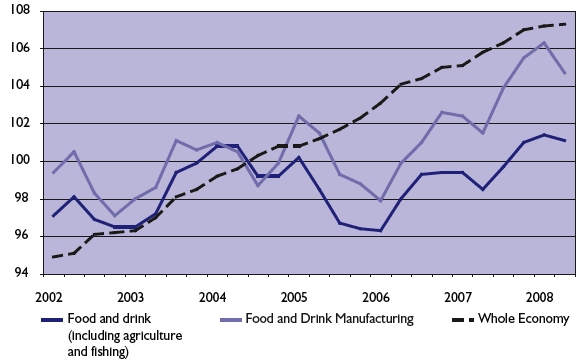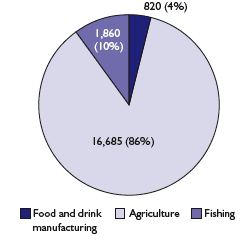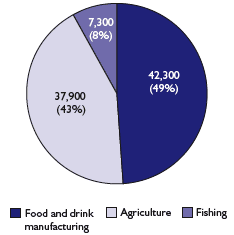Scottish Economic Statistics 2008
This is the ninth edition of the annual publication Scottish Economic Statistics, which is produced by statisticians in the Scottish Government.
B3 chapter three: Industry Sectors
Introduction
This chapter describes information on various industrial sectors of the economy - agriculture, fisheries, manufacturing, construction, services and tourism.
Scottish Annual Business Statistics
This chapter includes information on the sectors of the economy covered by the Office for National Statistics' Annual Business Inquiry ( ABI). Data are published by the Scottish Government under the heading Scottish Annual Business Statistics. Figures quoted for the services sector do not cover the financial sector or some of the public sector. This is referred to as the service sector for simplicity. For more detailed information, please visit the following web site: http://www.scotland.gov.uk/Topics/Statistics/16170/4363.
Trends and Comparisons
In 2006, turnover in the industries covered by the Annual Business Inquiry ( ABI) in Scotland amounted to £196 billion. Of this, £107 billion related to services, £38 billion to manufacturing, £26 billion to oil & gas and £14 billion to construction. The two industries making the largest contributions to these totals were both within services; wholesale and retail with a turnover of £21 billion each. (Tables 3.1 and 3.3)
Gross value added ( GVA) is a measure of the income generated by businesses after the subtraction of input costs, but before costs such as wages and capital investment are paid prior to arriving at figure for profit. In 2006, GVA for ABI covered businesses in Scotland amounted to £76 billion. Of this, £38 billion related to services, £15 billion to oil & gas, £13 billion to manufacturing and £6 billion to construction.
The latest figures show an increase in GVA1 and turnover figures between 2005 and 2006 in manufacturing, construction and services sectors. Since 2005, the main sectors saw the following rises in GVA: services up by £4.5 billion (14%), manufacturing up by £1.1 billion (9%) and construction up by £0.6 billion (12%). In terms of turnover, between 2005 and 2006, main sectors all increased as follows: services up by £10.7 billion (11%), manufacturing up by £2 billion (6%) and construction increased by £1.1 billion (8%).
Within the manufacturing sector, in 2006, the top industry contributors in terms of GVA were food & drink industry (£3.0 billion) followed by chemicals sector (£2.6 billion) and manufacture of fabricated metal products (£1.2 billion). Within the services sector, the top industry contributors in terms of GVA were 'other business activities' (£9.0 billion) (includes legal activities, architectural & engineering activities, labour recruitment and advertising) followed by retail (£5.4 billion) and wholesale (£4.7 billion). (Charts 3.1 & 3.2)
Chart 3.1: Shares of Gross Value Added in Manufacturing sector, 2006
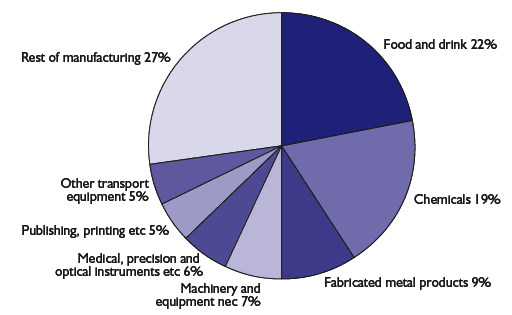
Source: Office for National Statistics, Annual Business Inquiry (compiled by Scottish Government)
Chart 3.2: Shares of Gross Value Added in Services sector 1, 2006
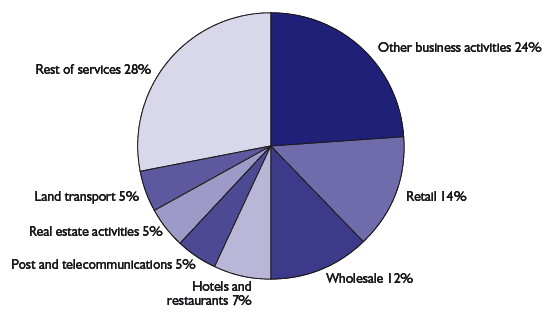
Office for National Statistics, Annual Business Inquiry (compiled by Scottish Government)
Note: 1. Services coverage excludes certain areas such as the financial sector and some of the public sector.
In 2006, GVA per employee (a measure of productivity) in manufacturing (£60,700) was nearly twice as high as that in services sector (£30,900). Whilst labour costs per employee in manufacturing (£28,200) were over 50% higher than in services (£18,400). The lower levels found in services partly reflects the higher level of part time working in this sector. ( Table 3.3)
Falkirk, Glasgow City, Fife and South Lanarkshire were the Local Authority areas with the highest gross value added in the manufacturing sector in 2006. In the services sector, the highest gross value added figures were found in Glasgow City, Edinburgh City, Aberdeen City and North Lanarkshire. (Tables 3.4 & 3.5)
In 2006, within manufacturing, foreign-owned companies accounted for 29 per cent of
GVA and 27 per cent of employees, whilst Scottish-owned firms contributed 43 per cent of GVA and 59 per cent of employees. Within services, foreign-owned companies accounted for 16 per cent of GVA and 12 per cent
of employees, whilst Scottish-owned firms contributed 57 per cent of GVA and 65 per cent of employees. ( Table 3.7)
GVA per employee indicates that foreign manufacturing companies (£66,600) were around 50% more productive than Scottish-owned firms (£44,200) in 2006. UK-owned (excluding Scotland) manufacturing companies had a higher GVA per employee figure of £117,100. GVA per employee indicates that foreign services firms (£42,000) were also around 50% more productive than Scottish-owned companies (£27,100). (Chart 3.3)
Chart 3.3: Gross Value Added Per Employee by sector and ownership, 2006
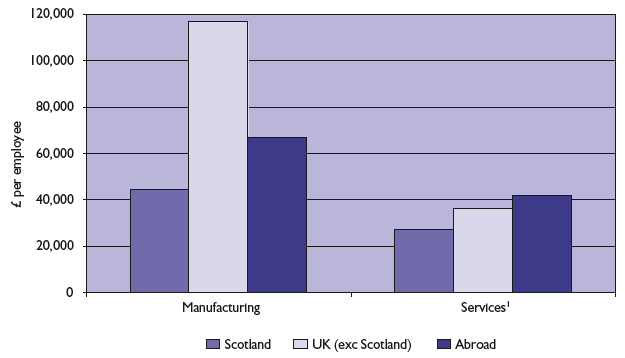
Source: Office for National Statistics, Annual Business Inquiry (compiled by Scottish Government)
Note: 1. Services coverage excludes certain areas such as the financial sector and some of the public sector and it has higher levels of part-time working.
Box 3.1: Focus on Food & Drink sector in Scotland - SIC 01, 05 and 15 Scotland's food and drink industry was identified in the Government Economic Strategy ( GES) 2 as one of the key sectors in which Scotland can build on existing comparative advantage and increase productivity and growth. The GES defines the Scottish food and drink industry as spanning the activities of agriculture ( SIC 01), fishing ( SIC 05) and food and drink manufacturing ( SIC 15). Production performance in the food and drink sector, as measured by the Quarterly GDP Index, has fluctuated over time. However, output is currently 6.4 per cent greater than it was in the same quarter a decade ago. The most recent GDP data (2008 Q2) shows that food and drink (including agriculture and fishing) experienced a fall in output of 0.3 per cent in the latest quarter, but growth of 1.7 per cent in year on year terms. For food and drink manufacturing alone, output fell by 1.5 per cent in 2008 Q2, but grew by 3.2 per cent in the latest four quarters compared to the previous four quarters. Chart 3A: GDP Index, 1998-2008 Q2
Source: Scottish Quarterly GDP Index, 2008 Q2 (2004=100) Statistics from the Annual Business Inquiry show that in 2006 Gross Value Added ( GVA), a measure of an industry's contribution to the economy, in the food and drink manufacturing sub-sector stood at £3 billion. In the same year, GVA in the fishing sub-sector was considerably less at £235 million. Data from the Rural and Environment Research and Analysis Directorate ( RERAD) show that in 2006 GVA in the agriculture sub-sector stood at £675 million. 3 In 2008, there were approximately 19,360 businesses, 13 per cent of all registered Scottish businesses, operating in the food and drink sector according to the Inter-Departmental Business Register ( IDBR). Of these enterprises, 86 per cent operated in the agriculture sub-sector. The fishing and food and drink manufacturing sub-sectors accounted for 10 per cent and 4 per cent of enterprises respectively in 2008. Virtually all enterprises in the agriculture (99.9 per cent) and fishing (99.5 per cent) sub-sectors are small, with less than 50 employees. Small enterprises account for a lesser proportion of the food and drink manufacturing sub-sector, accounting for 80 per cent of businesses. |
|||
Chart 3B: Enterprises by sub-sector, 2008
Source: Inter-Departmental Business Register, 2008 |
Chart 3C: Employment by sub-sector, 2007
Source: Labour Force Survey, 2007 (Jan-Dec) |
||
Data from the Labour Force Survey shows that in 2007 total employment in the food and drink industry stood at 87,400, accounting for around 3.5 per cent of total Scottish employment. Employment in the food and drink manufacturing sub-sector stood at 42,300 in 2007, accounting for almost half of employment in the sector. Employment in the agriculture sub-sector accounted for a similar proportion of jobs in the overall sector at 43 per cent (37,900 jobs), whilst the fishing sub-sector accounted for only 8 per cent of jobs (7,300 jobs). Self-employment in the food and drink sector accounted for 27 per cent of employment, at 23,400 jobs. Self-employment in the agriculture and fishing sub-sectors accounted for a significant proportion of jobs at 50 per cent and 48 per cent respectively. Employment in the food and drink sector has decreased substantially over the period 1998 to 2007, falling by 22 per cent overall. This was driven by manufacturing activity which saw a decline of 39 per cent in employment since 1998. Conversely, employment in agriculture increased over the period, rising by 11 per cent on its 1998 level. Gross weekly pay (full time jobs) in the food and drink sector stood at £377.4 in 2007. This compares poorly to an average weekly wage of £441.5 in the wider Scottish economy. The food and drink manufacturing sub-sector paid slightly better than the agriculture sub-sector with a weekly wage of £378.8 compared to £365.5. The latest Global Connections Survey shows that exports from the Scottish food and drink sector stood at approximately £3,855 million in 2006, accounting for 19% of all Scottish exports. Exports in the sector are dominated by manufacture of food and drink, of which the whisky industry is estimated to have exported around £3,300 million in 2006, accounting for 86% of total food and drink sector exports and 16% of all Scottish exports. Food and drink accounted for just 1.5 per cent, or £8.9 million worth of Scottish business expenditure on research and development in 2006. 4 Table 3A: Main Industries related to food and drink sector in 2004 |
|||
Input - Output Category |
Output (£m) |
Employment ( FTE) |
GVA (£m) |
|---|---|---|---|
TOTAL |
3,308 |
33,309 | 1,607 |
Wholesale distribution |
419 |
5,009 |
238 |
Banking |
428 |
4,169 |
261 |
Other land transport |
160 |
2,537 |
97 |
Source: 2004 Scottish Input-Output Tables and Multipliers The food and drink sector impacts upon other sectors of the Scottish economy through the purchases and sales it makes. The 2004 Input-Output tables show that in addition to the employment in the food and drink sector, there were a further 33,309 full time equivalent ( FTE) jobs related to purchases by the food and drink sector. The industries with the largest dependencies are shown above. |
|||
Tourism
A profile of the Scottish Tourism-Related Sector, from the most recent Scottish Annual Business Statistics ( SABS) 2006 publication, can be accessed via the following link. http://www.scotland.gov.uk/Topics/Statistics/16170/Tourism. Table 3.6 in this chapter also provides figures on Tourism-Related Sector at local authority level from the same source. Whilst, Map 3.1 shows Tourism-Related employees as percentage of all employees in local authorities, providing an indication of the importance of this sector to the economy in different areas of Scotland.
Two national surveys provide the main data on tourism: the ONS International Passenger Survey ( IPS), which surveys visitors to the UK at the point of exit from the UK, and the United Kingdom Tourism Survey ( UKTS) which asks UK residents about trips they have made. The Office for National Statistics ( ONS) publishes information on international tourism. For domestic tourism, the UKTS data are collected on behalf of the National Tourism Boards.
Due to changes in the ONSIPS and the UKTS, statistics for 2005 to 2007 are not directly comparable with previous years. Prestwick airport was introduced into the IPS sample in January 2005 and there was also a subsequent modification to the IPS system of calculating weights for contacts at UK regional airports. The new methodology prevents overestimates of traffic volumes to any particular UK region and additionally it prevents changes in traffic at remote locations in, for example, the south of England from affecting results in Scotland, and vice versa. Further details are available via the following link: http://www.statistics.gov.uk/about/methodology_by_theme/gini/Int_passenger_survey.asp.
Following an extensive review of tourism data, the UKTS underwent a methodology change in May 2005, with the survey moving from a telephone survey methodology to a face-to-face survey methodology. The change was brought about as a result of doubts in the validity of the survey data produced by the telephone survey methodology. Further details on the new methodology and the reasons for this change are available via the following link: http://www.scotexchange.net/research_and_statistics/new_methodology.htm.
Table 3.8 shows the estimates for the volume and value of tourism in Scotland in 2007. It can be seen from this that approximately half of overnight expenditure in Scotland was from other parts of the UK.
Further information on tourist trends and attitudes for Scotland is available from Tourism in Scotland 2007, which can be accessed via the following link: http://www.scotexchange.net/tourism_in_scotland_2007.pdf.
The Scottish E-Business Survey ( SEBS) (as discussed in Chapter 2) is carried out by Scottish Enterprise and Highland and Islands Enterprise, collates information on adoption of e-business applications and also attitudes to e-business and its perceived relevance to tourism-related businesses. Analysis of this has been done for tourism-related businesses and the results are published by Scottish Enterprise. This shows that the perceived importance of e-business continues to increase and this is reinforced by 87 per cent of e-business adopters stating that they have found some benefit, particularly increased efficiency. The main barrier to e-business adoption is that organisations do not believe it to be relevant.
Access to the internet (74%) has continued to rise amongst Tourism organisations. Within the last 12 months, broadband adoption has also seen substantial increases as more companies upgrade their existing dial up connections. 90 per cent of connected Tourism companies now have broadband which is slightly greater than the Scottish average.
Adoption of e-business technologies such as websites (62%) and Local Area Networks (36%) have shown an increase in 2007. Website adoption in particular is above average for businesses across Scotland. e-Business practices such as trading online (75%) have shown increases, again above the Scottish average.
Further information on the SEBS can be found on the Scottish Enterprise website: http://www.scottish-enterprise.com/economicresearch.
Agriculture and Fisheries
Agriculture accounted for 0.7 per cent of Scottish Gross Value Added in 2007 (at a UK level, agriculture contributes 0.5 per cent to total GVA). Comparisons for the countries of the UK can be seen in Chart 3.5 below. This also shows that agriculture accounted for around 2.5 per cent of employment in Scotland. More details on agriculture employment based on the annual agricultural census can be found in Table 4.7.
The Scottish Government Rural and Environment Research and Analysis Directorate ( RERAD) collect detailed information on farms' incomes and outputs. Table 3.9 summarises this data, details by type of farm can be found in the Economic Report on Scottish Agriculture ( http://www.scotland.gov.uk/Publications/2008/05/22090130/0). Total Income from Farming is calculated as net value added plus other subsidies minus the sum of hired labour, interest and rent. This was £628 million for Scotland in 2007.
Chart 3.4: Agriculture in the economy, 2007
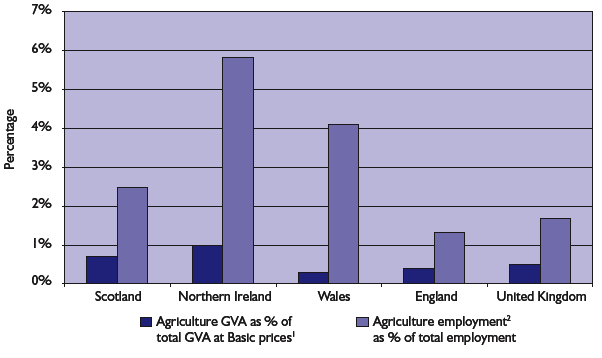
1 From 2005 onwards, Single Farm Payment is excluded from GVA 2 Source: (a) June Agriculture Census & (b) Labour Force Survey, Spring quarter 2007. Not seasonally adjusted.
Chart 3.5: Total Income From Farming ( TIFF) & Other Payments and Subsidies 1998-2007 in real terms (2007 prices)
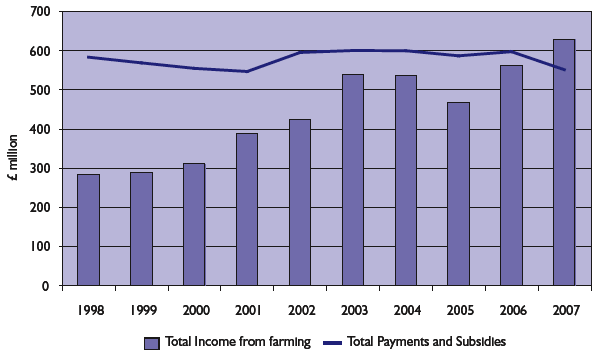
Source: Scottish Government, Rural Environment Research and Analysis Directorate.
Notes
1. From 2005 'Other Payments and Subsidies' includes Single Farm Payment ( SFP) which replaces most production related subsidies
The number of Scottish-based sea-fishing vessels has fallen from almost 3,000 in the early 1990s to just under 2,200 in 2007. This is largely as a result of decommissioning due to reduced fishing quotas. The corresponding number of fishermen employed has fallen from 9,420 in 1993 to a low of 5,155 in 2005, but has risen over the last
2 years to 5,424 in 2007. This rise in employment corresponds to the steady increase of total landings value since 2003. Chart 3.6 illustrates these trends. Detailed information on Scottish fisheries can be found in Scottish Fisheries Statistics ( http://www.scotland.gov.uk/Publications/2008/09/04090427/0).
Chart 3.6: The Scottish sea-fishing industry, 1996-2007
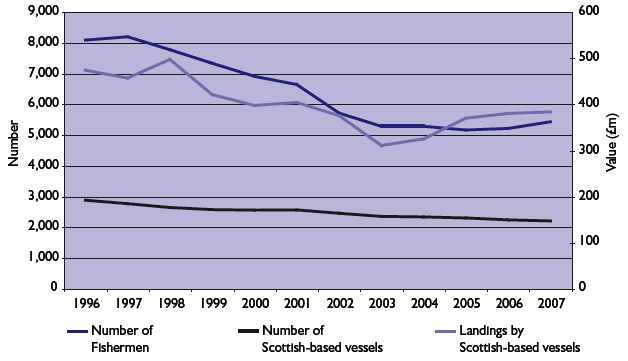
Source: Scottish Government Marine Directorate
Box 3.2: Useful references UK & Regional Annual Business Inquiry For UK & Regional Annual Business Inquiry statistics produced by the Office for National Statistics, please use link above. Scottish Neighbourhood Statistics For the latest edition of Scottish Neighbourhood Statistics, which includes data on a wide range of topics at detailed geographic levels, please use the link above. The Virtual Microdata Laboratory The Virtual Microdata Laboratory ( VML) is a facility within the Office for National Statistics ( ONS) which enables access to restricted microdata for research purposes. Researchers from government and academia use the VML to carry out research on ONS surveys and other confidential datasets. |
There is a problem
Thanks for your feedback
